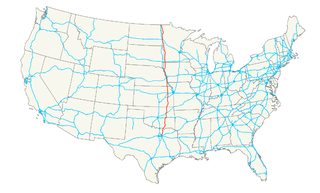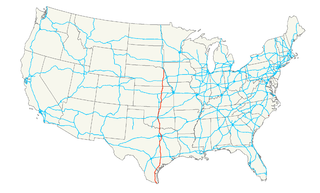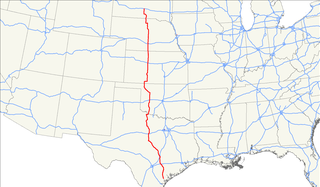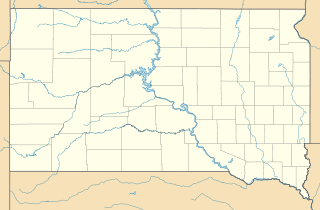Interstate 20 (I‑20) is a major east–west Interstate Highway in the Southern United States. I‑20 runs 1,539 miles (2,477 km) beginning near Kent, Texas, at I-10 to Florence, South Carolina, at I-95. Between Texas and South Carolina, I‑20 runs through northern Louisiana, Mississippi, Alabama, and Georgia. The major cities that I-20 connects to include Fort Worth, Texas; Dallas, Texas; Shreveport, Louisiana; Jackson, Mississippi; Birmingham, Alabama; Atlanta, Georgia; Augusta, Georgia; and Columbia, South Carolina.
U.S. Route 80 or U.S. Highway 80 (US 80) is a major east-west United States Numbered Highway in the Southern United States, much of which was once part of the early auto trail known as the Dixie Overland Highway. As the "0" in the route number indicates, it was originally a cross-country route, from the Pacific Ocean to the Atlantic Ocean. Its original western terminus was at Historic US 101 in San Diego, California. However, the entire segment west of Dallas, Texas, has been decommissioned in favor of various Interstate Highways and state highways. Currently, the highway's western terminus is at an interchange with Interstate 30 (I-30) on the Dallas–Mesquite, Texas city line. The highway's eastern terminus is in Tybee Island, Georgia near the Atlantic Ocean. Between Jonesville, Texas and Kewanee, Mississippi, US 80 runs parallel to or concurrently with Interstate 20. US 80 also currently runs through Dallas, Texas; Shreveport, Louisiana; Jackson, Mississippi; Montgomery, Alabama; Columbus, Georgia; Macon, Georgia; and Savannah, Georgia.

U.S. Route 75 is a major north–south U.S. Highway that extends 1,239 miles (1,994 km) in the central United States. The highway's northern terminus is in Noyes, Minnesota, at the Canadian border, where it once continued as Manitoba Highway 75 on the other side of the now-closed border crossing. Its southern terminus is at Interstate 30 (I-30) and I-45 in Dallas, where it is known as North Central Expressway.

U.S. Route 77 is a major north–south United States Numbered Highway which extends for 1,305 miles (2,100 km) in the central United States. As of 2005, Its southern terminus is in Brownsville, Texas, at Veteran's International Bridge on the Mexican border, where it connects with both Mexican Federal Highway 101 and Mexican Federal Highway 180, and the highway's northern terminus is in Sioux City, Iowa, at an interchange with Interstate 29 (I-29).

U.S. Route 81 or U.S. Highway 81 (US 81) is a major north–south U.S. highway that extends for 1,220 miles (1,960 km) in the central United States and is one of the original United States Numbered Highways established in 1926 by the American Association of State Highway Officials.

U.S. Route 83 (US 83) is a major north–south United States Numbered Highway that extends 1,885 miles (3,034 km) in the central United States. Only four other north–south routes are longer: US 1, US 41, US 59, and US 87. The highway's northern terminus is north of Westhope, North Dakota, at the Canadian border, where it continues as Manitoba Highway 83. The southern terminus is at the Veterans International Bridge in Brownsville, Texas. Together, US 83 and PTH 83 form a continuously numbered north-south highway with a combined distance is 3,450 kilometres.

U.S. Route 183 (US 183) is a north–south United States highway. The highway's northern terminus is in Presho, South Dakota, at an intersection with Interstate 90. Its southern terminus is in Refugio, Texas, at the southern intersection of U.S. Highway 77 and Alternate US 77.

The Santa Fe Trail was a 19th-century route through central North America that connected Franklin, Missouri with Santa Fe, New Mexico. Pioneered in 1821 by William Becknell, who departed from the Boonslick region along the Missouri River, the trail served as a vital commercial highway until 1880, when the railroad arrived in Santa Fe. Santa Fe was near the end of the El Camino Real de Tierra Adentro, which carried trade from Mexico City.

The National Register of Historic Places in the United States is a register including buildings, sites, structures, districts, and objects. The Register automatically includes all National Historic Landmarks as well as all historic areas administered by the U.S. National Park Service. Since its introduction in 1966, more than 90,000 separate listings have been added to the register.
Montana State Highway 1 (MT 1) is a state highway in Deer Lodge and Granite counties in southwestern Montana, United States, extending west and north from the Anaconda I-90 Junction to Drummond. Both the beginning and endpoints of the road are on Interstate 90. It is known as the Pintler Scenic Loop and provides access to the community of Philipsburg as well as the Georgetown Lake area and the Discovery Ski Area.
Saskatchewan, the middle of Canada's three prairie provinces, has an area of 588,276.09 square kilometres (227,134.67 sq mi) and population of 1,150,632, mostly living in the southern half of the province.

The Nebraska State Highway System consists of all the state highways in Nebraska maintained by the Nebraska Department of Roads. This includes federally designated Interstates and US Highways as well as state highways, links and spurs. The system comprises 9,942 miles (16,000 km) of state highways in all 93 counties. Highways within the system range in scale and quality from 10-lane urban freeways, such as I-80 around Omaha, to standard two-lane rural undivided highways as well as 39 miles (63 km) of state highways that remain unpaved such as N-67 north of Dunbar. Surrounding landscapes along the highway system range from the urban areas in Omaha and Lincoln to scenic journeys through uninhabited grasslands in the Nebraska Sandhills.
K-53 is a 6.177-mile-long (9.941 km) state highway in the U.S. State of Kansas. Located entirely within Sumner County, K-53's western terminus is at U.S. Route 81 (US-81) south of Wichita and the eastern terminus is at an interchange with K-15 by Mulvane. Along the way K-53 intersects Interstate 35 (I-35), also known as the Kansas Turnpike, at exit 33. The highway travels mostly through farmlands with the exception of inside Mulvane and is a two-lane road its entire length.
K-196 is a 28.474-mile-long (45.824 km) east–west state highway in Harvey and Butler Counties in the U.S. state of Kansas. K-196's western terminus is at Interstate 135 (I-135), U.S. Route 81 (US-81) and K-15 just south of Newton and the eastern terminus is at K-254 just east of El Dorado, Kansas. The highway runs along the south border the town of Whitewater and bypasses Potwin to the south.
K-28 is a 29.019-mile-long (46.702 km) state highway in the U.S. state of Kansas. K-28's western terminus is at K-14 in Jewell, and the eastern terminus is at K-9 west of Concordia. K-28 passes through the cities of Randall and Jamestown as well as the unincorporated community of Yuma. The highway also passes within one mile (1.6 km) of the Jamestown Wildlife Area, a popular hunting and fishing destination. The highway is a two-lane paved road its entire length.

The Meridian Highway Bridge is a bridge that formerly carried U.S. Route 81 across the Missouri River between Nebraska and South Dakota. The Meridian Highway Bridge connects Yankton, South Dakota with rural Cedar County, Nebraska. The Meridian Bridge is a double deck bridge, with the top level having carried traffic into South Dakota from Nebraska, and the lower level having carried traffic into Nebraska from South Dakota.
U.S. Highway 75 is a part of the United States Numbered Highway System that runs for 1,239 miles (1,994 km) from Dallas, Texas to Kittson County, Minnesota where it ends just short of the Canada–United States border. Within the State of Nebraska it is a state highway that enters Nebraska on the Kansas state line about 9 miles (14 km) south of Dawson and travels north across the extreme eastern portion of the state, to the Nebraska–Iowa border in South Sioux City where it crosses the Missouri River along a concurrency with Interstate 129. The northern 210 miles (340 km) of the route generally travels parallel to the Missouri River. The 87.32-mile (140.53 km) section between the I-680 interchange in Omaha and the Interstate 129 interchange is designated the Lewis & Clark Scenic Byway, one of nine scenic byways in the state.
U.S. Route 81 (US-81) is a north–south U.S. highway running through the central United States' Great Plains region, from Fort Worth, Texas to the U.S.–Canadian border at Pembina, North Dakota. A 229.28-mile (368.99 km) segment of the highway lies within the state of Oklahoma. US-81 crosses the Red River from Texas south of Terral, passing through several Oklahoma cities, such as Chickasha, El Reno, Kingfisher, and Enid, before entering Kansas north of Renfrow.

Maverick Junction, South Dakota, United States, is an unincorporated community located in Fall River County at the intersection of South Dakota Highway 79 and US Highways 18 and 385, approximately five miles southeast of Hot Springs.
U.S. Highway 75 (US 75) is a United States Highway in northwestern Iowa. It begins at the Missouri River on a bridge with Interstate 129 (I-129) and US 20. Immediately upon landing in Iowa from Nebraska, I-129 ends at an interchange with I-29. US 20 and US 75 continue around Sioux City on a four-lane expressway until US 20 exits to the east. US 75 heads to the north-northeast, parallel to the Floyd River, until Le Mars. There, Iowa Highway 60 (Iowa 60) continues northeastward on the expressway while US 75 heads due north. Near Hull, it is briefly overlapped by US 18. It leaves the state and enters Minnesota north of Rock Rapids.











